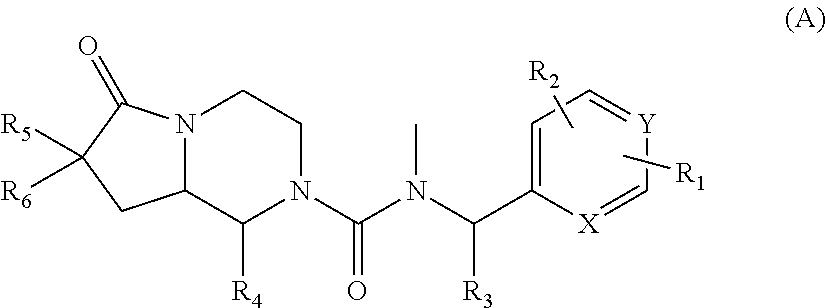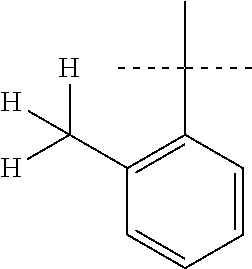Novel neurokinin 1 receptor antagonist compounds ii
a neurokinin and receptor technology, applied in the field of heterocyclic compounds, can solve the problems of systemic side effects, serious compromising of patients' quality of life, and pruritus, and achieve the effects of favourable safety profile, high metabolic clearance, and favourable ratio
- Summary
- Abstract
- Description
- Claims
- Application Information
AI Technical Summary
Benefits of technology
Problems solved by technology
Method used
Image
Examples
example 1 & 2
Compound 1 & 2
N—((R)-1-(3,5-bis(trifluoromethyl)phenyl)ethyl)-1-(2,4-dimethylphenyl)-N-methyl-6-oxohexahydropyrrolo[1,2-a]pyrazine-2(1H)-carboxamide (single trans isomers with unknown configuration)
[0691]
[0692]To a solution of triphosgene (65 mg, 0.22 mmol) in EtOAc (10 mL) at 0° C. was added solution of intermediate 3 (mixture of trans, 120 mg, 0.49 mmol), DMAP (4 mg, 0.035 mmol) and TEA (150 mg, 1.5 mmol) in EtOAc (2 mL). The mixture was stirred for 1.5 h at room temperature, followed by addition of (R)-1-(3,5-bis(trifluoromethyl)phenyl)-N-methylethanamine (266 mg, 0.98 mmol) and TEA (107 mg, 1.05 mmol) in EtOAc (2 mL). The reaction was stirred at 45° C. for 48 h and quenched with sat. NH4Cl (aq) solution. The resulting mixture was extracted with EtOAc (2×20 mL). The combined organic layers were washed with brine, dried over anhydrous Na2SO4 and then concentrated in high vacuum. The residue was purified by Prep-HPLC to give the title compound 1 (10 mg, 4%) and compound 2 (10 mg, 4...
example 3
Compound 3
N-(3,5-bis(trifluoromethyl)benzyl)-1-(2,4-dimethylphenyl)-N-methyl-6-oxohexahydropyrrolo[1,2-a]pyrazine-2(1H)-carboxamide (mixture of trans isomers)
[0695]
[0696]To a solution of triphosgene (65 mg, 0.22 mmol) in EtOAc (10 mL) at 0° C. was added solution of intermediate 3 (mixture of trans, 120 mg, 0.49 mmol), DMAP (4 mg, 0.035 mmol) and TEA (209 μL, 1.5 mmol) in EtOAc (2 mL). The mixture was stirred for 1.5 h at room temperature, followed by addition of 1-(3,5-bis(trifluoromethyl)phenyl)-N-methylmethanamine (251 mg, 0.98 mmol) and TEA (107 mg, 1.05 mmol) in EtOAc (2 mL). The reaction was stirred at 45° C. for 48 h and quenched with sat. NH4Cl (aq) solution. The resulting mixture was extracted with EtOAc (2×20 mL). The combined organic layers were washed with brine, dried over anhydrous Na2SO4 and then concentrated in high vacuum. The residue was purified by Prep-HPLC to give the title compound 3 (10 mg, 4%). 1H NMR (600 MHz, CDCl3) δ 7.74 (s, 1H), 7.38 (s, 2H), 7.14 (d, J=7...
example 4 & 5
Compound 4 & 5
1-(2,4-dimethylphenyl)-N-methyl-N—((R)-1-(3-methyl-5-(trifluoromethyl)phenyl)ethyl)-6-oxohexahydropyrrolo[1,2-a]pyrazine-2(1H)-carboxamide
[0697]
[0698]To a solution of triphosgene (47.2 mg, 0.16 mmol) in EtOAc (1 mL) at 0° C. was added solution of intermediate 3 (mixture of trans, 100 mg, 0.32 mmol), DMAP (4 mg, 0.035 mmol) and TEA (97 mg, 0.96 mmol) in EtOAc (2 mL). The mixture was stirred for 1.5 h at room temperature, followed by addition of 1-(3,5-bis(trifluoromethyl)phenyl)-N-methylmethanamine (251 mg, 0.98 mmol) and TEA (107 mg, 1.05 mmol) in EtOAc (2 mL). The reaction was stirred at 45° C. for 48 h and quenched with sat. NH4Cl (aq) solution. The resulting mixture was extracted with EtOAc (2×20 mL). The combined organic layers were washed with brine, dried over anhydrous Na2SO4 and then concentrated in high vacuum. The residue was purified by Prep-HPLC to give the title compound 4 (76 mg, yield: 38%) and compound 5 (62 mg, yield: 28%).
[0699]Compound 4: 1H NMR (400...
PUM
| Property | Measurement | Unit |
|---|---|---|
| time | aaaaa | aaaaa |
| time | aaaaa | aaaaa |
| time | aaaaa | aaaaa |
Abstract
Description
Claims
Application Information
 Login to View More
Login to View More - R&D
- Intellectual Property
- Life Sciences
- Materials
- Tech Scout
- Unparalleled Data Quality
- Higher Quality Content
- 60% Fewer Hallucinations
Browse by: Latest US Patents, China's latest patents, Technical Efficacy Thesaurus, Application Domain, Technology Topic, Popular Technical Reports.
© 2025 PatSnap. All rights reserved.Legal|Privacy policy|Modern Slavery Act Transparency Statement|Sitemap|About US| Contact US: help@patsnap.com



